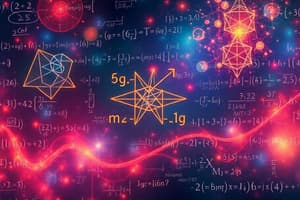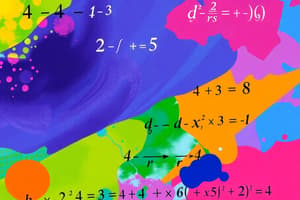Podcast
Questions and Answers
What is the primary purpose of factoring in algebra?
What is the primary purpose of factoring in algebra?
- To find the perimeter of geometric shapes.
- To break down expressions into products of simpler factors. (correct)
- To determine the degree of an equation.
- To combine like terms in an expression.
Which of the following is an example of a quadratic equation?
Which of the following is an example of a quadratic equation?
- 2x + 3 = 5
- y = 4x
- 3x² - 4x + 5 = 0 (correct)
- x - 1 = 0
What defines a linear equation?
What defines a linear equation?
- It cannot have variables on both sides.
- It is a first-degree equation in its variables. (correct)
- It includes quadratic terms.
- It involves multiple operations with exponents.
In geometry, how is the area of a rectangle calculated?
In geometry, how is the area of a rectangle calculated?
What does the Pythagorean theorem state about right triangles?
What does the Pythagorean theorem state about right triangles?
Which type of angle measures greater than 90° but less than 180°?
Which type of angle measures greater than 90° but less than 180°?
What is the surface area of a cube with side length $s$?
What is the surface area of a cube with side length $s$?
Which statement best describes a function in mathematics?
Which statement best describes a function in mathematics?
Flashcards are hidden until you start studying
Study Notes
Algebra
-
Definition: Branch of mathematics dealing with symbols and the rules for manipulating those symbols.
-
Key Concepts:
- Variables: Symbols (e.g., x, y) representing numbers.
- Expressions: Combinations of variables and constants (e.g., 3x + 2).
- Equations: Statements that two expressions are equal (e.g., 2x + 3 = 7).
- Functions: Relations that assign exactly one output for each input (e.g., f(x) = 2x + 1).
-
Operations:
- Addition and Subtraction: Combining like terms (e.g., 3x + 2x = 5x).
- Multiplication and Division: Distributive property (e.g., a(b + c) = ab + ac).
-
Types of Equations:
- Linear Equations: First-degree equations (e.g., y = mx + b).
- Quadratic Equations: Second-degree equations (e.g., ax² + bx + c = 0).
- Polynomial Equations: Involves terms with non-negative integer exponents.
-
Factoring: Breaking down expressions into products of simpler factors (e.g., x² - 9 = (x - 3)(x + 3)).
-
Solving Equations: Finding values of variables that satisfy the equation (e.g., isolate x).
Geometry
-
Definition: Branch of mathematics concerning the properties and relationships of points, lines, surfaces, and solids.
-
Key Concepts:
- Points, Lines, and Planes: Basic building blocks of geometry.
- Angles: Formed by two rays with a common endpoint (measured in degrees).
- Types: Acute (< 90°), Right (= 90°), Obtuse (> 90°).
-
Shapes:
- 2D Shapes: Circles, triangles, rectangles, etc.
- Perimeter: Sum of the lengths of the sides.
- Area: Measure of the space inside the shape.
- 3D Shapes: Cubes, spheres, cylinders, etc.
- Volume: Measure of the space occupied by the solid.
- Surface Area: Total area of the surface of the solid.
- 2D Shapes: Circles, triangles, rectangles, etc.
-
Theorems:
- Pythagorean Theorem: In right triangles, ( a² + b² = c² ).
- Similarity and Congruence: Shapes that are similar (same shape, different size) or congruent (same size and shape).
-
Coordinate Geometry: Study of geometric figures using a coordinate system.
- Distance Formula: (\sqrt{(x_2 - x_1)² + (y_2 - y_1)²}).
- Midpoint Formula: (\left(\frac{x_1 + x_2}{2}, \frac{y_1 + y_2}{2}\right)).
-
Transformations: Operations that alter the position or size of shapes.
- Types: Translations, rotations, reflections, dilations.
Algebra
-
Branch of mathematics focused on symbols and their manipulation.
-
Variables represent numbers through symbols such as x and y.
-
Expressions are formed by combining variables with constants, like 3x + 2.
-
Equations assert the equality of two expressions, exemplified by 2x + 3 = 7.
-
Functions create a relationship offering a unique output for each input, for example, f(x) = 2x + 1.
-
Operations in algebra include:
- Addition and Subtraction to combine like terms, e.g., 3x + 2x sums to 5x.
- Multiplication and Division applying the distributive property, such as a(b + c) equating to ab + ac.
-
Different Types of Equations:
- Linear Equations: First-degree expressions, represented as y = mx + b.
- Quadratic Equations: Second-degree forms, structured as ax² + bx + c = 0.
- Polynomial Equations consist of terms with non-negative integer exponents.
-
Factoring involves expressing a polynomial as products of simpler components, like x² - 9 being expressed as (x - 3)(x + 3).
-
Solving Equations is the process of determining variable values that fulfill the equation, typically isolating x.
Geometry
-
A field of mathematics focused on points, lines, surfaces, and solids.
-
Basic Elements include points, lines, and planes, the foundational components of geometry.
-
Angles are created by two rays sharing a common starting point and measured in degrees.
- Types of Angles: Acute (< 90°), Right (= 90°), Obtuse (> 90°).
-
Shapes are categorized into:
- 2D Shapes, such as circles, triangles, and rectangles, with relevant metrics:
- Perimeter: Total length around the shape.
- Area: Total space enclosed within the shape.
- 3D Shapes, including cubes, spheres, and cylinders with metrics:
- Volume: Space the solid occupies.
- Surface Area: Total exterior area of the solid.
- 2D Shapes, such as circles, triangles, and rectangles, with relevant metrics:
-
Prominent Theorems include:
- Pythagorean Theorem: In right triangles, a² + b² equals c², establishing a relationship between side lengths.
- Similarity and Congruence differentiate shapes that maintain the same shape but differ in size (similar) from shapes that are identical in size and shape (congruent).
-
Coordinate Geometry employs a coordinate system to analyze geometric properties.
- Distance Formula used to calculate the distance between two points is √((x₂ - x₁)² + (y₂ - y₁)²).
- Midpoint Formula determines the midpoint of a line segment as ((x₁ + x₂)/2, (y₁ + y₂)/2).
-
Transformations modify the position or appearance of geometric shapes encompassing:
- Translations: Shifting a shape without altering its orientation.
- Rotations: Turning a shape around a point.
- Reflections: Flipping a shape over a line.
- Dilations: Resizing a shape in proportion to the original.
Studying That Suits You
Use AI to generate personalized quizzes and flashcards to suit your learning preferences.




